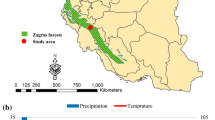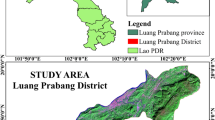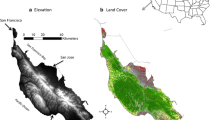Abstract
Globally, tropical forests are being perturbed by human activity. Tropical vegetation constitutes some of the largest terrestrial carbon stocks against the build up of greenhouse gases. In this paper, a local-scale case study utilising remote sensing methodology in estimating forest loss is presented, for a section of tropical South Africa’s Soutpansberg Mountains where land use pressure threatens some of the last remaining indigenous forests. Landsat TM images from October 1990, August 2000 and September 2006 were used, together with municipality level demographic data. Hybrid image classification techniques distinguished forest cover on the images, which were classified into vegetation density categories. About 20% of forest and woodland cover was lost in the 16-year analysis period, mainly due to pine and eucalyptus plantation and residential housing expansions. The local-scale key drivers behind the deforestation are examined.







Similar content being viewed by others
References
Alves DS (2002) Space-time dynamics of deforestation in Brazilian Amazonia. Int J Remote Sens 23:2903–2908. doi:10.1080/01431160110096791
Archard F, Eva HD, Stibig H-J, Mayaux P, Gallego J, Richards T et al (2002) Determination of deforestation rates of the world’s humid tropical forests. Science 297:999–1002. doi:10.1126/science.1070656
Binns JA, Illgner PM, Nel EL (2001) Water shortage, deforestation and development: South Africa’s working for water programme. Land Degrad Dev 12:341–355. doi:10.1002/ldr.455
Brandt JS, Townsend PA (2006) Land use–land cover conversion, regeneration and degradation in the high elevation Bolivian Andes. Landscape Ecol 21:607–623. doi:10.1007/s10980-005-4120-z
Buchanan GM, Butchart SHM, Dutson G, Pilgrim JD, Steininger MK, Bishop DK et al (2008) Using remote sensing to inform conservation status assessment: estimates of recent deforestation rates on New Britain and the impacts upon endemic birds. Biol Conserv 141:56–66. doi:10.1016/j.biocon.2007.08.023
Bucini G, Hanan NP (2007) A continental-scale analysis of tree cover in African savannas. Glob Ecol Biogeogr 16:593–605. doi:10.1111/j.1466-8238.2007.00325.x
Butt MJ, Everard DA, Geldenhuys CJ (1994) The distribution and composition of vegetation types in the Soutpansberg–Blouberg mountain complex. Report FOR DEA-814. Environmental Conservation Research Programme, Department of Environmental Affairs and Tourism, Pretoria
Chavez PS (1988) An improved dark object subtraction technique for atmospheric scattering correction of multispectral data. Remote Sens Environ 24:459–479. doi:10.1016/0034-4257(88)90019-3
Clark PE, Seyfried MS, Harris B (2001) Intermountain plant community classification using Landsat TM and SPOT HRV data. J Range Manage 54:152–160. doi:10.2307/4003176
Coppin P, Jonckheere I, Nackaerts K, Muys B, Lambin E (2004) Digital change detection methods in ecosystem monitoring: a review. Int J Remote Sens 25:1565–1596. doi:10.1080/0143116031000101675
DeFries R, Achard F, Brown S, Herold M, Murdiyarso D, Schlamadinger B et al (2007) Earth observations for estimating greenhouse gas emissions from deforestation in developing countries. Environ Sci Policy 10:385–394. doi:10.1016/j.envsci.2007.01.010
Department of Environmental Affairs and Tourism (2003) Overview State of the Environment Limpopo. DEAT, Pretoria, South Africa
Dezso Z, Bartholy J, Pongracz R, Barcza Z (2005) Analysis of land-use/land-cover change in the Carpathian region based on remote sensing techniques. Phys Chem Earth 30:109–115
Du Plessis MA (2000) The effects of fuelwood removal on the diversity of some cavity-using birds and mammals in South Africa. Biol Conserv 74:77–82. doi:10.1016/0006-3207(95)00016-W
DWAF (2005) Pilot state of the forest report: a pilot report to test the national criteria and indicators. Department of Water Affairs and Forestry, Pretoria
Edwards D (1983) A broad-scale structural classification of vegetation for practical purposes. Bothalia 14:705–712
Foody GM, Palubinskas G, Lucas RM, Curran PJ, Honzak M (1996) Identifying terrestrial carbon sinks: classification of successional stages in regenerating tropical forest form Landsat TM data. Remote Sens Environ 55:205–216. doi:10.1016/S0034-4257(95)00196-4
Friedl MA, McIver DK, Hodges JCF, Zhang XY, Muchoney D, Strahler AH et al (2002) Global land cover mapping from MODIS: algorithms and early results. Remote Sens Environ 83:287–302. doi:10.1016/S0034-4257(02)00078-0
Grouzis M, Akpo LE (1997) Influence of tree cover on herbaceous above-and below-ground phytomass in the Sahelian zone of Senegal. J Arid Environ 35:285–296. doi:10.1006/jare.1995.0138
Hansen MC, DeFries RS, Townshend JRG, Marufu L, Sohlberg R (2002) Development of a MODIS tree cover validation data set for Western Province, Zambia. Remote Sens Environ 83:320–335. doi:10.1016/S0034-4257(02)00080-9
Hansen MC, DeFries RS, Townshend JRG, Carroll M, Dimiceli C, Sohlberg RA (2003) Global percent tree cover at a spatial resolution of 500 meters: first results of the MODIS vegetation continuous fields algorithm. Earth Interact 10:1–15. doi:10.1175/1087-3562(2003)007<0001:GPTCAA>2.0.CO;2
Hill RA (1999) Image segmentation for tropical forest classification in Landsat TM data. Int J Remote Sens 20:1039–1044. doi:10.1080/014311699213082
Jensen JR (2005) Introductory digital image processing: a remote sensing perspective, 3rd edn. Prentice Hall, Eaglewood Cliffs
Kogan F, Gitelson A, Zakarin E, Spivak L, Leved L (2003) AVHRR-based spectral vegetation index for quantitative assessment of vegetation state and productivity: calibration and validation. Photogramm Eng Remote Sens 69:899–906
Lambin EF (1999) Monitoring forest degradation in tropical regions by remote sensing: some methodological issues. Glob Ecol Biogeogr 8:191–198. doi:10.1046/j.1365-2699.1999.00123.x
Lillesand TM, Kiefer RW, Chipman JW (2004) Remote sensing and image interpretation, 5th edn. Wiley, New York
Limpopo Provincial Government (2004) Limpopo growth and development strategy 2004–2014. Limpopo Provincial Government, Polokwane
Lu D, Mausel P, Brondizio E, Moran E (2002) Assessment of atmospheric correction methods for Landsat TM data applicable to Amazon basin LBA research. Int J Remote Sens 23:2651–2671. doi:10.1080/01431160110109642
Lu D, Mausel P, Brondizio E, Moran E (2004) Change detection techniques. Int J Remote Sens 20:2365–2407. doi:10.1080/0143116031000139863
Mason MJ (2001) El Niño, climate change, and Southern African climate. Environmetrics 12:327–345. doi:10.1002/env.476
Mouat DA, Mahin GG, Lancaster J (1993) Remote sensing techniques in the analysis of change detection. Geocarto Int 2:39–50
Mucina L, Rutherford MC (eds) (2006) The Vegetation of South Africa, Lesotho and Swaziland, Strelitzia 19. SANBI, Pretoria, South Africa
Myers N (1988) Tropical deforestation and remote sensing. For Ecol Manag 23:215–225
Patenaude G, Milne R, Dawson TP (2005) Synthesis of remote sensing approaches for forest carbon estimation: reporting to the Kyoto Protocal. Environ Sci Policy 8:161–178. doi:10.1016/j.envsci.2004.12.010
Phua M-H, Tsuyuki S, Furuya N, Lee JS (2008) Detecting deforestation with a spectral change detection approach using multitemporal landsat data: a case study of Kinabalu Park, Sabah, Malaysia. J Environ Manage 88:784–795. doi:10.1016/j.jenvman.2007.04.011
Prins E, Kikula IS (1996) Deforestation and regrowth phenology in miombo woodland—assessed by Landsat Multispectral Scanner System data. For Ecol Manage 84:263–266
Sánchez-Azofeifa GA, Harriss RC, Skole DL (2001) Deforestation in Costa Rica: a quantitative analysis using remote sensing imagery. Biotropica 33:378–384
Serra P, Pons X, Sauri D (2003) Post-classification change detection with data from different sensors: some accuracy considerations. Int J Remote Sens 24:3311–3340. doi:10.1080/714110283
Shimabukuro YE, Batista GT, Mello EMK, Moreira JC, Duarte V (1998) Using shade fraction image fragmentation to evaluate deforestation in Landsat Thematic Mapper images of the Amazon Region. Int J Remote Sens 19:535–541. doi:10.1080/014311698216152
Smith RE (1991) Effects of clearfelling pines on water yield in a small Eastern Transvaal catchment, South Africa. Water SA 17:217–224
Stoms DM, Estes JE (1993) A remote sensing agenda for mapping and monitoring biodiversity. Int J Remote Sens 14:1839–1860. doi:10.1080/01431169308954007
Thompson M (2004) Differences in the extent and transformation of South Africa’s woodland biome as determined from two national databases. In: Lawes MJ, Eeley HAC, Shackleton CM, Geach BGS (eds) Indigenous forests and woodlands in South Africa: policy, people and practice. University of KwaZulu Natal Press, Scottsville
Tottrup C (2004) Improving tropical forest mapping using multi-date Landsat TM data and pre-classification image smoothing. Int J Remote Sens 25:717–730. doi:10.1080/01431160310001598926
Vågen T-G (2006) Remote sensing of complex land use change trajectories—a case study from the highlands of Madagascar. Agric Ecosyst Environ 115:219–228. doi:10.1016/j.agee.2006.01.007
Acknowledgments
This research was facilitated by a Cooperation Fund grant from the Council for Scientific and Industrial Research (CSIR), for collaborative research with the University of Venda.
Author information
Authors and Affiliations
Corresponding author
Rights and permissions
About this article
Cite this article
Munyati, C., Kabanda, T.A. Using multitemporal Landsat TM imagery to establish land use pressure induced trends in forest and woodland cover in sections of the Soutpansberg Mountains of Venda region, Limpopo Province, South Africa. Reg Environ Change 9, 41–56 (2009). https://doi.org/10.1007/s10113-008-0066-4
Received:
Accepted:
Published:
Issue Date:
DOI: https://doi.org/10.1007/s10113-008-0066-4




